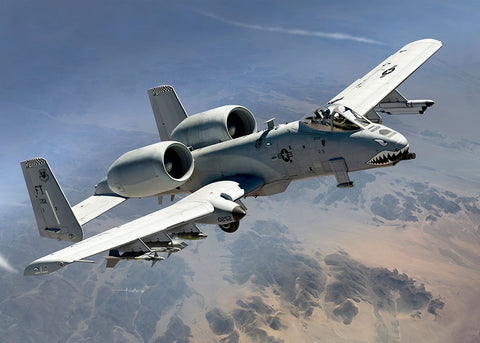 Designers saw further potential in the F-15's design to adapt to the air-to-surface strike mission. With the F-111's service life rapidly coming to an end, McDonnell Douglas adapted a two-seat version of the aircraft to employ new night-attack sensors called LANTIRN, (Low Altitude Navigation and Targeting Infrared for Night), increased fuel capacity using conformal fuel tanks (FAST (fuel and sensor tactical) packs), an increased gross weight for the additional fuel and a significant payload, and more powerful Pratt & Whitney F100 engines to push the lot aloft. The result was the F-15E Strike Eagle, nicknamed Beagle (Bomber Eagle) or simply Mud Hen. This aircraft remains at the forefront of the USAF's strike capability, while versions of the F-15E have been exported to various Air Forces around the world.
Designers saw further potential in the F-15's design to adapt to the air-to-surface strike mission. With the F-111's service life rapidly coming to an end, McDonnell Douglas adapted a two-seat version of the aircraft to employ new night-attack sensors called LANTIRN, (Low Altitude Navigation and Targeting Infrared for Night), increased fuel capacity using conformal fuel tanks (FAST (fuel and sensor tactical) packs), an increased gross weight for the additional fuel and a significant payload, and more powerful Pratt & Whitney F100 engines to push the lot aloft. The result was the F-15E Strike Eagle, nicknamed Beagle (Bomber Eagle) or simply Mud Hen. This aircraft remains at the forefront of the USAF's strike capability, while versions of the F-15E have been exported to various Air Forces around the world.When the USAF started operations in Operation Desert Shield and Desert Storm, the F-15s swept the skies of Iraqi fighters while the F-15E used its precision strike capabilities to pick apart the Iraqi war machine. Even more than ten years later, new generations of aircrews took these very same aircraft into Afghanistan in OEF and back to Iraq in OIF, and the Eagle remains supreme. The F-15E's two-person crew enabled one Strike Eagle to respond to a distress call after a Blackhawk had been forced down and its crew were pinned down by mortar fire. The F-15E crew saw the survivors' infrared beacon with their night vision goggles (NVGs) while the flash of the mortar was visible without. With the backseater monitoring speed and altitude, the pilot did something that transformed night operations - they successfully straffed the mortar position (they were out of bombs before they arrived) and saved the Blackhawk crew.
|
Features and options in this kit:
External stores include:
The subtitle to this kit is the 333rd Fighter Squadron and indeed, one of the three subjects is from the 333rd, but the other two options are from the other two sister squadrons:
|
















